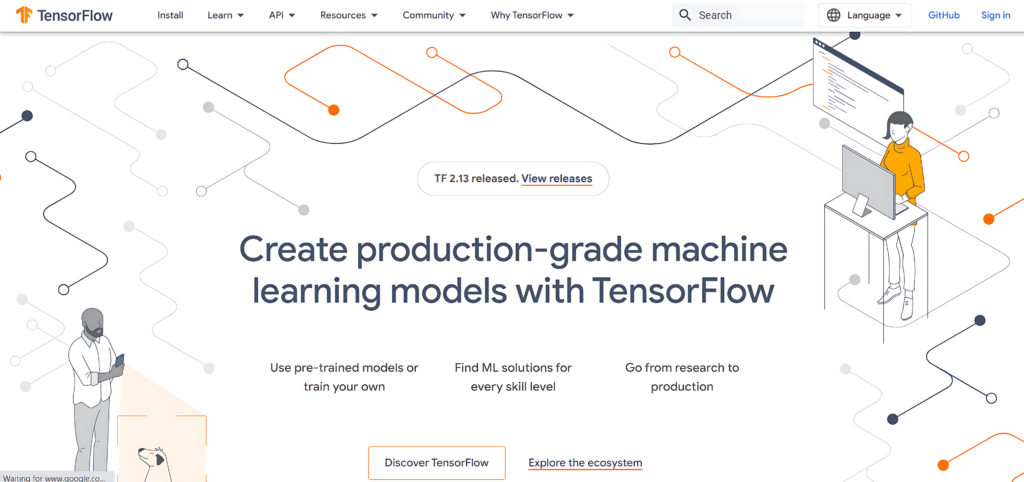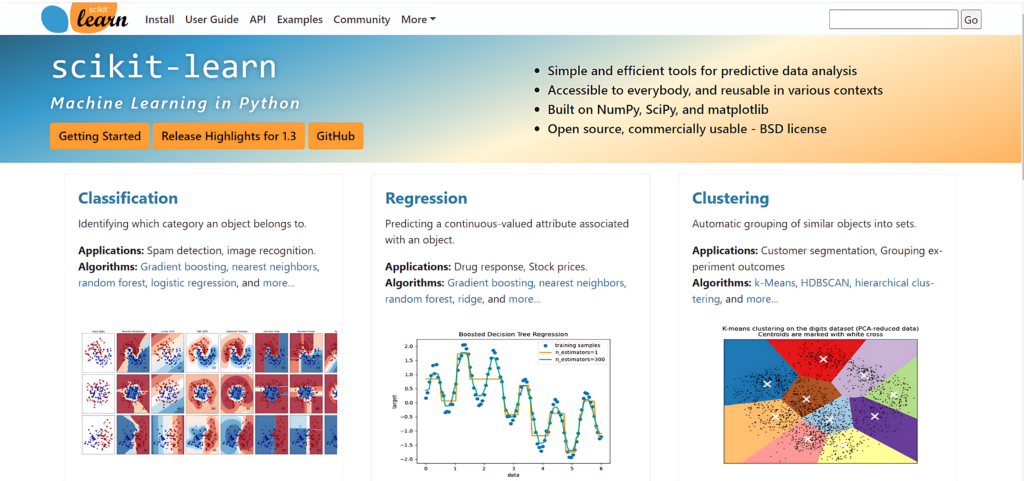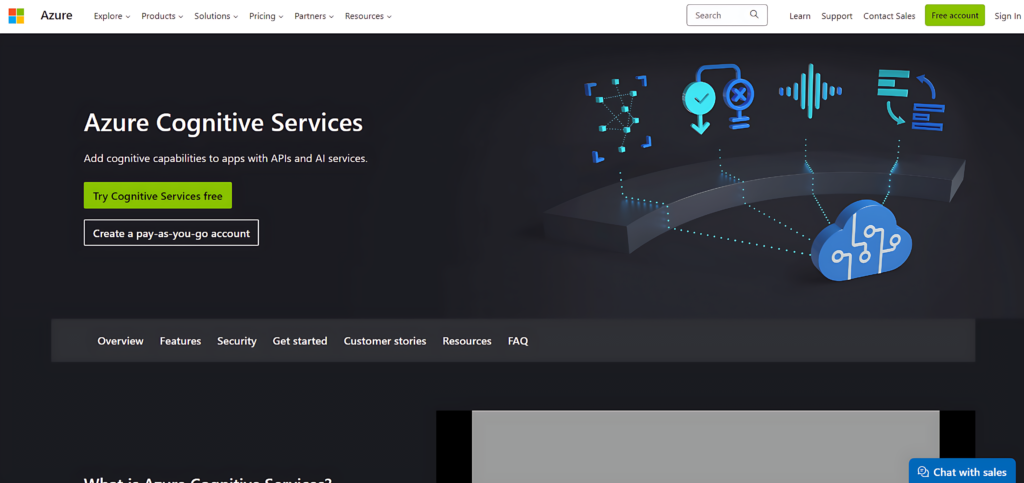In the ever-evolving landscape of artificial intelligence (AI), free and readily available open-source AI tools have emerged as the driving force behind pioneering innovations and practical applications. These tools empower individuals, developers, and organizations, providing access to AI’s boundless potential without the burden of exorbitant expenses. In this extensive guide, we will delve into five prominent and cost-free AI tools that have taken center stage: TensorFlow, OpenAI GPT-3.5, Scikit-learn, IBM Watson Studio, and Microsoft Azure Cognitive Services. We will thoroughly examine their features, applications, and the transformative influence they wield over the AI landscape.
Table of Contents
TensorFlow: Spearheading the AI Revolution
TensorFlow, born from the minds at Google, stands as an open-source machine learning framework that has become synonymous with the forefront of AI innovation. Here’s a deep dive into its significance:

Attributes:
- Versatility: TensorFlow endorses a multitude of AI tasks, spanning machine learning, deep learning, natural language processing, and computer vision.
- Scalability: It is meticulously designed to handle projects of all scales, from small prototypes to large-scale deployments.
- Community Support: TensorFlow’s vibrant community contributes to its extensive library of pre-built models, making development faster and more accessible.
- TensorBoard: A visualization tool that provides the capability to monitor and analyze training sessions.
Applications:
- Visual Cognition: TensorFlow powers visual cognition in various applications, from self-driving cars to medical diagnostics.
- Natural Language Processing (NLP): It is utilized in chatbots, sentiment analysis, and language translation.
- Recommendation Systems: TensorFlow is used to build recommendation algorithms for e-commerce and content platforms.
OpenAI GPT-3.5: Revolutionary Language Constructs

OpenAI GPT-3.5, a creation of OpenAI, has garnered reverence for its extraordinary language processing capabilities. It stands as a prominent contender in the sphere of natural language understanding:
Attributes:
- Paragon of Linguistic Proficiency: GPT-3.5 ranks among the most sophisticated language models, with the capacity to craft text that bears an uncanny resemblance to human composition.
- Flexibility: It can be meticulously tuned for specific tasks, rendering it adaptable to a gamut of applications.
- Content Generation: GPT-3.5 is adept at composing content, answering inquiries, and facilitating the craft of creative prose.
Applications:
- Content Fabrication: GPT-3.5 is deployed in the generation of articles, product descriptions, and promotional verbiage.
- Conversational Agents: It imparts exceptional conversational aptitudes to chatbots.
- Linguistic Transmutation: GPT-3.5 eases the process of real-time language translation and interpretation.
Scikit-learn: The Swiss Army Knife of Machine Learning
Scikit-learn represents an open-source machine learning library that has etched a reputation as a versatile and beginner-friendly instrument:

Attributes:
- User-Friendly Interface: Scikit-learn’s uncomplicated and uniform API design positions it as a formidable choice for novices.
- Panoply of Algorithms: It proffers a wide array of machine learning algorithms, encompassing categorization, regression, clustering, and dimensionality reduction.
- Model Evaluation: Scikit-learn furnishes tools tailored for the evaluation of models and the fine-tuning of hyperparameters.
Applications:
- Categorization and Regression: It finds employment in tasks such as the identification of email spam, the categorization of images, and predictive analytical frameworks.
- Cluster Analysis: Scikit-learn aids in the identification of patterns in data, such as the segmentation of clientele for commercial enterprises.
IBM Watson Studio: Ascending AI Development
IBM Watson Studio emerges as IBM’s all-encompassing platform for data science and AI progression. While it extends an invitation through its free tier, it also provides remunerative alternatives for more extensive utilization:

Attributes:
- Collaborative Milieu: Watson Studio lends its support to collaborative teamwork and version management for AI endeavors.
- Data Refinement: It provisions tools for the refinement, transmutation, and investigation of data.
- AutoAI: This functionality assists in the automation of AI model creation.
Applications:
- Prognostic Maintenance: Watson Studio proves invaluable in forecasting the imperative moments when machinery and equipment demand servicing, thereby curtailing downtime.
- Client Insight: It facilitates the scrutiny of client data, furthering the cause of marketing and customer service enhancements.
Microsoft Azure Cognitive Services: AI at Your Beck and Call
Microsoft Azure Cognitive Services constitutes a compendium of cloud-based AI services that encompass abilities in the spheres of vision, speech, language, and decision-making:

Attributes:
- Seamless Incorporation: Azure Cognitive Services integrate harmoniously with the pantheon of Microsoft’s products and services.
- Customizability: These services are amenable to customization to dovetail with the precise prerequisites and scenarios of individual businesses.
- Robust API: These services proffer thoroughly documented APIs, simplifying their assimilation into applications.
Applications:
- Visual and Cinematic Analysis: Azure Cognitive Services come into play in facial recognition, content moderation, and the detection of objects in images and videos.
- Verbal and Linguistic Processing: They empower the conversion of spoken words into written text, linguistic translation, and the analysis of sentiments in applications.
Conclusion
These AI tools that are gratis and accessible to all, including TensorFlow, OpenAI GPT-3.5, Scikit-learn, IBM Watson Studio, and Microsoft Azure Cognitive Services, have democratized the realm of AI. They bring the potency of machine learning and artificial intelligence within the reach of developers, businesses, and researchers, thereby fueling innovation across an array of industries.
As you embark on your journey in the realm of AI, contemplate the unique strengths and attributes of each tool, aligning them with your particular requisites. The AI revolution is no longer the exclusive purview of titanic tech conglomerates; it has transmuted into a revolution accessible to all, where inventiveness and innovation know no frontiers. With these cost-free AI tools at your disposal, you hold the potential to reshape the future and unveil the extraordinary prospects within the domain of artificial intelligence.

1 thought on “5 Best AI Tools That Are Free”